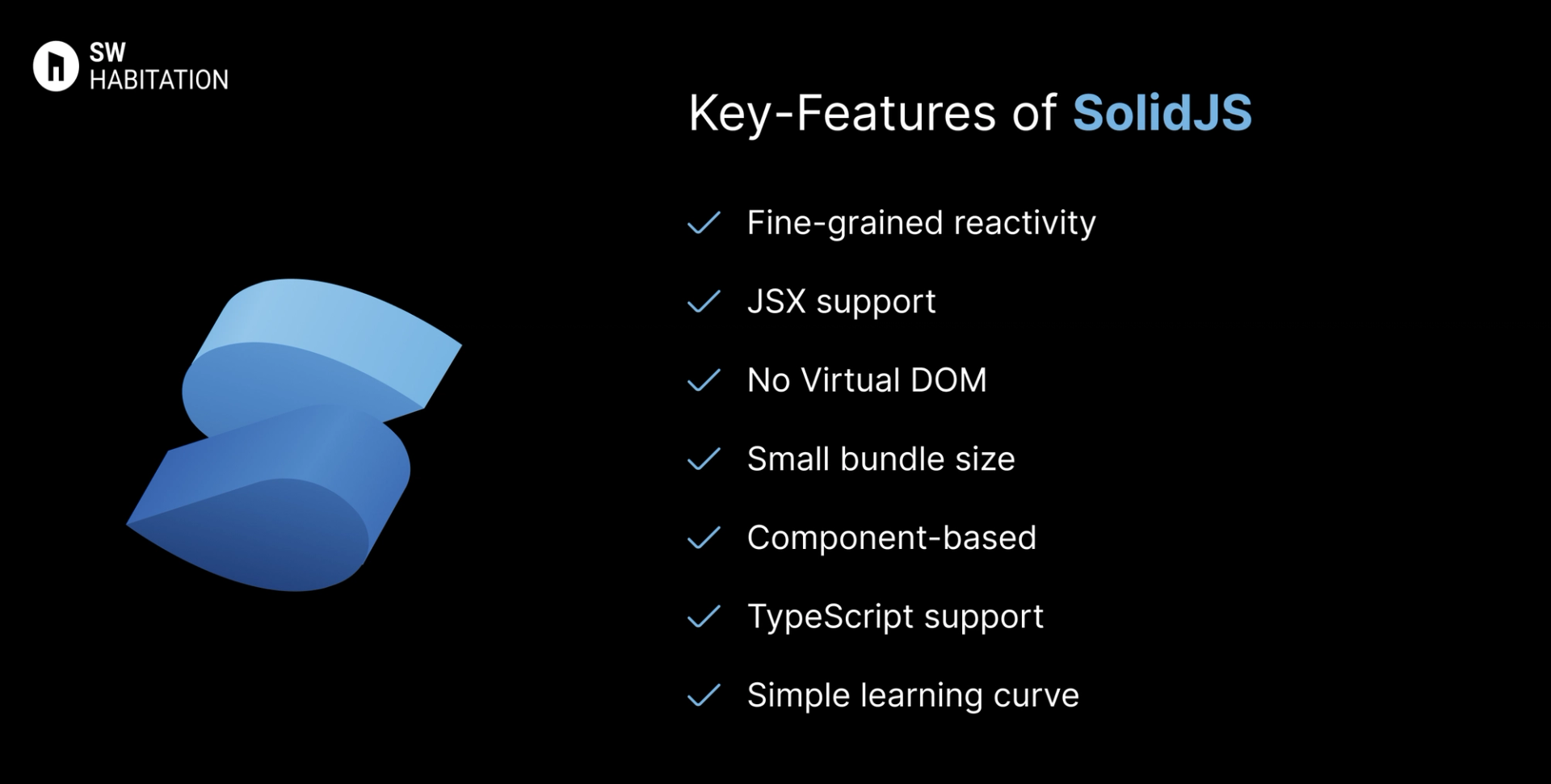SolidJS vs. SvelteKit

SolidJS

SvelteKit
So, you know when you want to build a website or app, but doing everything from scratch feels kinda overwhelming? That’s where web frameworks come in. They’re like a ready-made set of tools and building blocks that help you get things up and running way faster. Instead of figuring out every little piece yourself, a framework gives you a solid base to build on, and lets you focus on making something cool.
What is SolidJS?
SolidJS is a modern reactive JavaScript library for building fast, declarative user interfaces. Inspired by React, it focuses on fine-grained reactivity and compiles templates to efficient JavaScript code, making applications both lightweight and performant.
Unlike React, SolidJS doesn’t use a virtual DOM. Instead, it updates only the parts of the DOM that change, resulting in better performance and smaller bundle sizes.
Key Features of SolidJS


- Fine-grained reactivity: Updates DOM precisely where needed, without re-rendering entire components.
- JSX support: Uses JSX syntax, making it easy for React developers to learn.
- No Virtual DOM: Direct DOM updates for better performance and lower memory usage.
- Small bundle size: Lightweight, leading to faster load times.
- Component-based: Similar to React, it uses reusable, composable components.
- TypeScript support: First-class TypeScript support for type safety.
- Simple learning curve: Easy for developers familiar with React or modern frontend frameworks.
Advantages of SolidJS
- Performance: Outperforms most frameworks thanks to fine-grained reactivity and DOM compilation.
- React-Like Syntax: Easy for React developers to adopt.
- Small & Lightweight: Tiny runtime with minimal overhead.
- Flexible State Management: Built-in signals and stores reduce the need for external libraries.
- SSR Ready: Great for SEO-driven apps like blogs or e-commerce.
Disadvantages of SolidJS
- Smaller Ecosystem: Fewer libraries, tools, and community packages compared to React or Vue.
- Learning Curve: React developers may need to unlearn Virtual DOM patterns.
- Evolving Framework: Still relatively young, so some integrations (like CMS or UI libraries) may require custom solutions.
- Smaller Community: Less support and fewer tutorials compared to React.
What is SvelteKit?
SvelteKit is the full-stack application framework built for the Svelte (https://svelte.dev/) UI library. Unlike traditional frameworks that run in the browser, Svelte compiles your code to highly optimized JavaScript at build time which means no virtual DOM, minimal runtime, and ultra-fast performance.
SvelteKit brings everything you need to build web apps into one unified toolchain routing, layouts, API endpoints, server-side rendering (SSR), static site generation (SSG), client-side navigation, and more — all with smart defaults and deep configurability.
Key Features of SvelteKit


- Blazing Performance: Thanks to Svelte’s compiler-based approach, apps are lean, fast, and minimal.
- SSR, SSG, CSR – You Choose: Build pages using static generation, server rendering, or client-side rendering per route.
- Built-in Routing and Layouts: File-based routing with nested layouts simplifies app structure.
- Adapters for Deployment: Deploy to any platform — Netlify, Vercel, Cloudflare Workers, Node, or static hosting.
- TypeScript & Scoped Styling: Comes with TypeScript support and CSS scoped to components.
Advantages of SvelteKit
- Minimal JavaScript: Only ships what the user needs, no heavy runtime.
- Unified Experience: Routing, layouts, endpoints, and rendering are all built-in.
- Flexible Deployment: Use adapters to deploy anywhere, from edge functions to static hosts.
- Developer Happiness: Clean syntax, fewer abstractions, and fast HMR (Hot Module Reloading).
- Excellent SEO: SSR and pre-rendering make your content crawlable by default.
Disadvantages of SvelteKit
- Smaller Ecosystem: Compared to React or Vue frameworks, it has fewer plugins/modules.
- Learning Curve for Beginners: Svelte syntax is simple, but newcomers may need time to grasp server/client boundaries in SvelteKit.
- Tooling Stability: While stable, SvelteKit is still evolving and may change more rapidly than older frameworks.
- Advanced Use Cases: Handling complex authentication, authorization, or large-scale caching may need custom solutions.
Comparison Between SolidJS vs SvelteKit
Use Cases of SolidJS
- E-commerce Apps: High-performance, dynamic UIs with fast updates.
- Blogs & Portfolios: SEO-friendly with SSR support.
- Dashboards: Real-time data updates with fine-grained reactivity.
- Interactive SPAs: Complex applications with minimal overhead.
- Cross-Platform Apps: With Solid Start (meta-framework), you can build full-stack apps.
Use Cases of SvelteKit
- Technical Blogs & Portfolios
- Dashboards & SaaS Platforms
- Marketing Websites
- E-commerce Sites
- APIs & Endpoints
Other Resources
Conclusion
Web frameworks make building websites and apps a whole lot easier. Whether you’re working on a personal project or something big for work, they help with the heavy lifting—like routing, design structure, and how everything connects.
With support for things like server-side rendering, optimized performance, and developer-friendly features, these tools let you create faster, smarter, and cleaner websites. Just pick the one that fits your style, and start building something awesome 🚀
Frequently asked questions
Is SolidJS better than React?
SolidJS is faster, but React has a bigger ecosystem.
Does SolidJS use JSX?
Yes, just like React.
Can I use SolidJS with TypeScript?
Yes, it has full TypeScript support.
Can I use npm packages with SolidJS?
Yes, but React-specific libraries may not work.
Does SolidJS support SSR?
Yes, SolidJS has built-in SSR support.
Is SvelteKit production-ready?
Yes. SvelteKit reached 1.0 stable in late 2022 and is now considered production-ready. Many companies are already using it for production apps.
Can I migrate my existing Svelte app to SvelteKit?
Yes. You can move your Svelte components into a SvelteKit project and then set up routing, data loading, and server logic. The migration is straightforward but may require some restructuring.
Does SvelteKit support TypeScript?
Yes. TypeScript support is built-in. You can enable it when creating your project with npm create svelte@latest.
Which rendering modes does SvelteKit support?
SvelteKit supports SSR (Server-Side Rendering), SSG (Static Site Generation), CSR (Client-Side Rendering), and even hybrid setups in a single app.
